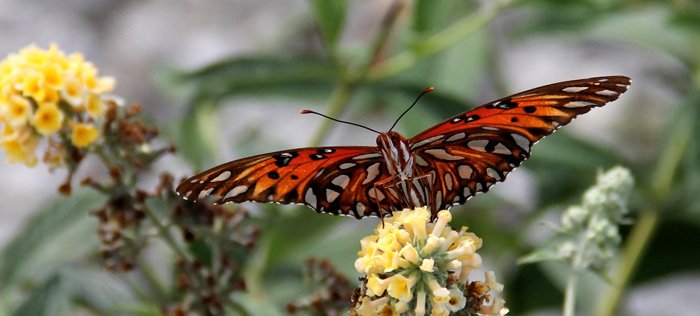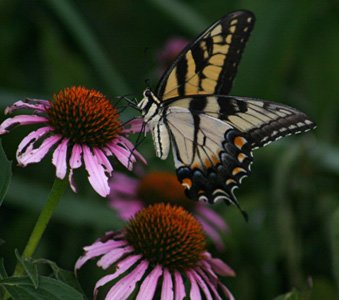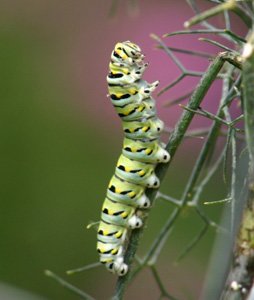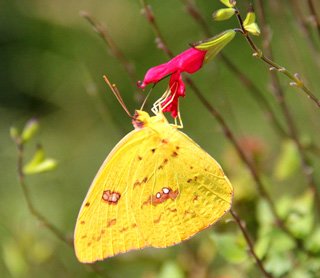





Many gardeners want to attract butterflies to their gardens but don't have a clue where to start. The best thing to remember is that famous line adapted from the movie 'Field of Dreams'...”If you build it, they will come.”
 Creating a place in your garden where butterflies want to gather is not that hard. They have just a few requirements and in most gardens there's a spot that is ideal. Butterflies need nectar sources, sunshine, a damp spot to puddle and host plants. Planning for these four things will most likely result in more winged visitors to your garden.
Creating a place in your garden where butterflies want to gather is not that hard. They have just a few requirements and in most gardens there's a spot that is ideal. Butterflies need nectar sources, sunshine, a damp spot to puddle and host plants. Planning for these four things will most likely result in more winged visitors to your garden.
Adult butterflies usually live for two to four weeks, their main purpose in life is to mate and produce young, so having an ideal spot for them to eat and search for the opposite sex is the first thing a potential butterfly gardener should plan for.
 Nectar sources keep adult butterflies interested in your garden and they are usually attracted to bright colors like yellow and red. Since butterflies prefer sunny areas, plants that thrive in full sun are the best choices. Butterflies are cold-blooded and need the sunshine to warm their wings and bodies enough for them to fly. They are generally the most active in the hottest part of the day and on cloudy or cooler days, you'll find them perched with their wings open to absorb as much of the sun's warmth as possible.
Nectar sources keep adult butterflies interested in your garden and they are usually attracted to bright colors like yellow and red. Since butterflies prefer sunny areas, plants that thrive in full sun are the best choices. Butterflies are cold-blooded and need the sunshine to warm their wings and bodies enough for them to fly. They are generally the most active in the hottest part of the day and on cloudy or cooler days, you'll find them perched with their wings open to absorb as much of the sun's warmth as possible.
Basic, old-fashioned flowers are often the best choices. Zinnias and coneflowers are perfect nectar sources and they are cheap and easy to grow. Butterflies are also attracted to plants in the mint family, asters and native wildflowers. Cultivated, hybrid flowers may not produce nectar and are often passed over by butterflies in favor of their plainer cousins, so pay attention to what is blooming in the fields along your roadsides.
 Butterflies also need a place to lay their eggs and a momma butterfly is pretty picky when it comes to selecting the perfect plant. She lands on a number of plants and 'tastes' each one with her feet to determine the correct host species. It is a good idea to research the your local butterflies to see what host plants they prefer, as each species has just a few plants that they use and a female will choose not to lay eggs at all, rather than lay them on a plant that is incompatible to her young. Plant your host plants in an unobtrusive area of your garden, because chances are, the leaves will be caterpillar-chewed and unattractive by season's end. Some butterflies use trees, such as ash and willow as host plants, so if your local butterflies are in that group, you can landscape with those preferences in mind. The caterpillars do not usually cause enough damage to harm the trees either.
Butterflies also need a place to lay their eggs and a momma butterfly is pretty picky when it comes to selecting the perfect plant. She lands on a number of plants and 'tastes' each one with her feet to determine the correct host species. It is a good idea to research the your local butterflies to see what host plants they prefer, as each species has just a few plants that they use and a female will choose not to lay eggs at all, rather than lay them on a plant that is incompatible to her young. Plant your host plants in an unobtrusive area of your garden, because chances are, the leaves will be caterpillar-chewed and unattractive by season's end. Some butterflies use trees, such as ash and willow as host plants, so if your local butterflies are in that group, you can landscape with those preferences in mind. The caterpillars do not usually cause enough damage to harm the trees either.
 Male butterflies like to 'puddle'. This activity takes place in a sunny, damp area where they gather to sip the minerals from moist stones or earth. It is thought that salts and other substances not found in nectar is necessary for reproduction and the males transfer the nutrients to the females during mating, so both sexes benefit. A bare spot in the sun, that you can keep damp attracts them. Just hang a container with a slow drip over the soil and you can even put a 'dummy' butterfly or two in place to let the guys know that the bar is open. They'll find it.
Male butterflies like to 'puddle'. This activity takes place in a sunny, damp area where they gather to sip the minerals from moist stones or earth. It is thought that salts and other substances not found in nectar is necessary for reproduction and the males transfer the nutrients to the females during mating, so both sexes benefit. A bare spot in the sun, that you can keep damp attracts them. Just hang a container with a slow drip over the soil and you can even put a 'dummy' butterfly or two in place to let the guys know that the bar is open. They'll find it.
The best thing to remember is to keep it simple. Simple, old-fashioned or native flowers, a sunny spot and a little research into the plants your local butterfly species use as hosts should start you on the path to a garden filled with fluttering wings.
Copyright © www.100flowers.win Botanic Garden All Rights Reserved